 May 2023
Nature does not hurry, yet everything is accomplished.
Lao Tzu
 Shown above, raft cones in Blue Lake, in Mystery II, the cave section visitors get to tour on the Lantern Tour. BELOW: The otherworldly lake featured on this year's Minnesota state park vehicle permit is Turquoise Lake, in Mystery I.
With 13 miles of underground passages, Mystery Cave at Forestville/Mystery Cave State Park is Minnesota's longest cave. It was named by local kids hired to help dig mud and debris from passageways. Legend has it one of the boys said, “We should call this place Mystery Cave ‘cause it’s a mystery why we’re working down here!”
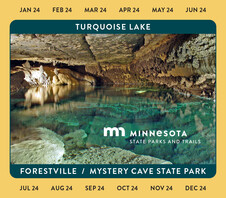
Raft cones, folia, botryoides and keyhole passages are only some of the many features that make Mystery Cave relevant. As water percolates through the cave, new formations are always (very slowly) developing. Factors that affect the growth rate of cave formations include the amount of water penetrating from the surface, the water's acidity, and the minerals in the soil and rock above.
Intrigued? Join us in for an armchair tour of Mystery Cave, with bits of ancient history and geology, before you book your in-person guided tour.
|

Mystery Cave represents geological and climatic forces working in sync on long time scales. Giant tectonic plates have been moving around slowly for at least three billion years, resulting in huge changes in the world’s landforms.
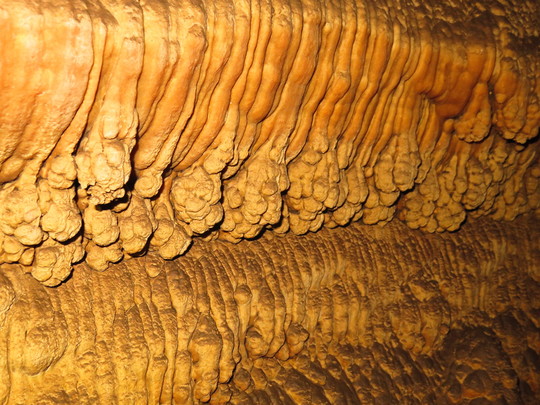 Flowstone slowly forms from a seeping flow of calcite-rich water. While much of Mystery Cave's massive flowstones are 12,000 years old or less, the oldest are more than 350,000 years old.
About 450 million years ago, during the early “Ordovician Period,” what we now think of as Minnesota was near Earth’s Equator and partially submerged below the surface of a shallow sea. As sea levels rose and fell, layers of sediment washed off the land and accumulated on the sea floor, eventually turning into the rocks that define the geology of Mystery Cave.
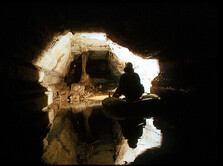
These sea level changes were produced by large climatic variations resulting from the Earth-sun relationship. The Earth’s tilt, rotation and orbit around the sun all change in cyclical patterns over eons, affecting the amount of sunlight reaching the planet. When less sunlight enters our atmosphere, the globe cools, leading to ice ages that reduce sea level dramatically. As the sunlight intensifies, Earth enters warm periods that melt the ice cover and lead to higher sea levels.
You can find many clues of the effects of these cycles in Mystery Cave. For instance, the shelfstones by Turquoise Lake (pictured below) indicate that water levels in the cave remained fairly steady for thousands of years, possibly linked to the glacial meltwaters that flowed through southeast Minnesota.
|
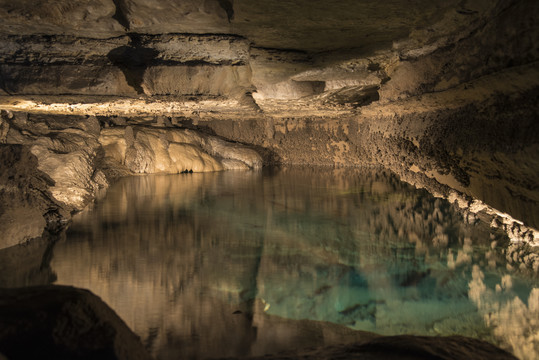 Shelfstone is a type of speleothem (geological formation) that grows inwards from the edge of a cave pool. It takes the form of ledges that tend to be flat on top and sloping underneath. The shelfstone above the current water level in a pool is an indicator of past levels of the pool. Shelfstone can be very thick when the water level has stayed constant over a long period of time.
How do we know the current warming period isn’t just these same cycles?
Natural climatic cycles require hundreds to thousands of years to register detectable changes, while Earth's current warming is detectable on scales of years to decades. Additionally, when the world warms from natural cycles, it’s because more sunlight is entering our atmosphere. NASA observations show sunlight has decreased slightly during Earth's current period of rapid warming.
Content developed in collaboration with Kenny Blumenfeld, with the Minnesota State Climatology Office.

All cave tours are guided by one of our knowledgeable naturalists, and explore different sections of Mystery Cave. What tour will you choose?
Book online before the end of the season!
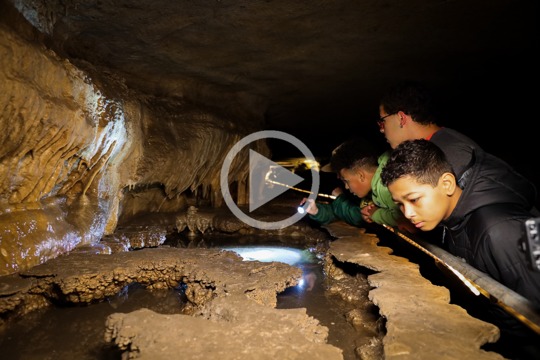 Click on the photo to watch a PBS Prairie Sportsman segment with highlights of what you'll see on tours.
Scenic cave tours start May 13
See illuminated cave formations and mineral deposits as well as pools, passageways and Turquoise Lake. Many formations are actively dripping. This stroller- and wheelchair-accessible tour involves 3/4 mile of walking on modern paved trails and metal bridges.
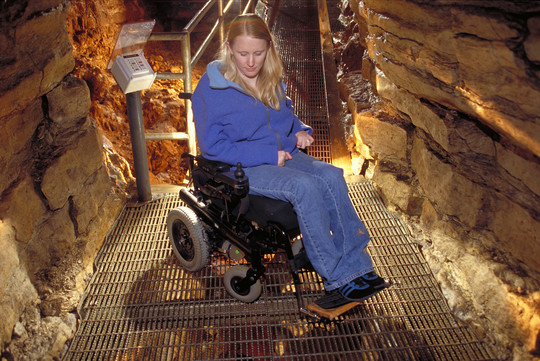 Photography tours start June 4
Take your tripods or monopods underground and spend a couple of hours discovering cave features for your most unique composition yet.
 Lantern tours start Memorial Day
Learn about cave geology as you travel on rugged gravel paths and up and down stone stairs. You'll have a lantern to illuminate the long, straight passages and Blue Lake. Choose between a one- or two-hour tour depending on how much geology you're ready to learn and how long you're willing to walk.
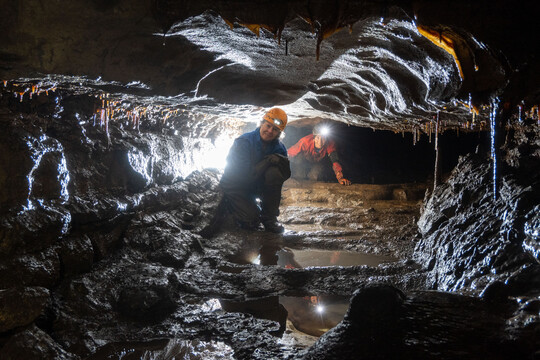 Wild caving tours start June 3
Are you ready to climb, crawl, stoop and slide to traverse through narrow cave passages? The wild caving tour is for you! You'll travel 1.6 miles up and down, over mud, dirt and boulders. Bring your own boots and we'll provide the necessary caving garb, including coveralls, helmets, headlamps, small packs, gloves and kneepads.
 Underground creatures and researchers.
Researchers go underground to search for creatures that have adapted to survive in Mystery Cave's cold, wet and dark conditions.
 Traveling in a cave isn’t easy! It often requires crawling through mud, cold water and over slippery, rock-filled passages. Heavy waterproof bags help keep instruments and other tools dry.
Caves provide critical habitat for many unique creatures. Aside from bats, most animals who live in caves are invertebrates, like spiders, millipedes and crickets. They were driven underground over 10,000 years ago by advancing glaciers and adapted to survive in caves.
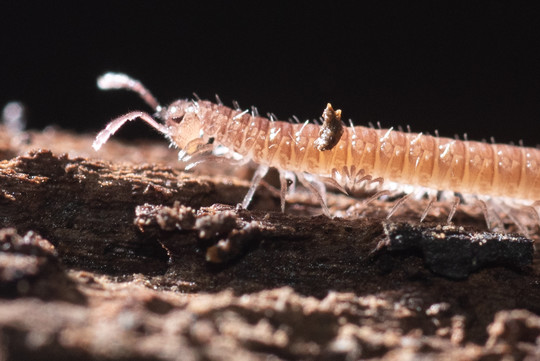 This millipede, discovered only a couple of years ago, is endemic to Mystery Cave. Like many other cave-adapted insects, it's blind and colorless. PHOTO: Jean Krejca
Adaptation
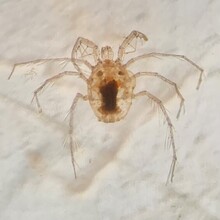
Above ground, we produce skin pigment to get protection from ultra-violet rays. With no sun exposure, cave-dwelling creatures don't need pigment and most are either white or translucent. You can actually see the insides of this acari mite (photo).
No sun also means it's dark in the cave. The energy used to produce and use eyes is diverted to support other functions. Most cave-adapted animals have reduced or no eyes at all! Some animals even use the area where their eyes would be to store fat from food.
In lieu of eyes, longer appendages are used to sense potential predators and feel around in the dark. For instance, cave spiders often have longer legs and cave crickets have longer antennae than their surface counterparts.
|
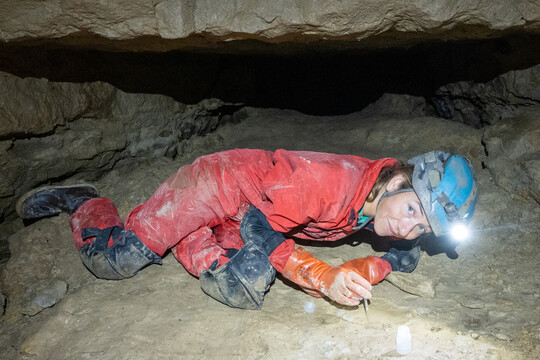 Cave researchers use special equipment, including helmets, headlamps and wetsuits.
Research
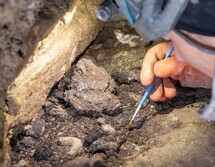
There are many techniques and tools to find cave creatures. Researchers use anchovy paste and Limburger cheese to attract animals. Surveyors examine visible surfaces, subterranean roots, pools of water, the undersides of rocks... and even search for invertebrates on animal scat! Animal finds are documented on a map of the cave.
Researchers also record temperature and humidity to understand the cave environment and future effects of climate change.
|
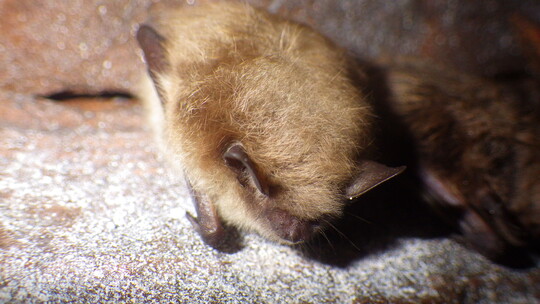 Species of bats that have been found in Mystery Cave include little brown bats, northern long eared bats, tri-colored bats and big brown bats. Due to white nose syndrome, bat numbers are generally down 95%. Although other species may still be present, during the 2023 winter hibernacula count, only 38 bats were documented in the cave and 34 of those were little browns (pictured). The other four were big browns. PHOTO: Melissa Boman.
Interconnectedness
The fascinating and diverse cave animals are part of the many resources Forestville/Mystery Cave State Park protects. Caves provide us with an opportunity to investigate how interconnected we are with the natural world - above and below ground. When we leave the surface and go underground, from one extreme to the other, we discover that each world is reflective of the other.
Cave animals are highly sensitive to change. The animals who live in Mystery Cave act as indicator species. Their ability to survive is dependent on the quality of our groundwater — the same water that we rely on for drinking, recreation and agricultural purposes.
Mystery Cave is a conduit for our groundwater. Surface water flows through Mystery Cave. It returns back up through springs that flow into streams. Contaminated surface water can become groundwater pollution and pose a health threat to cave animals and to humans alike.
|
